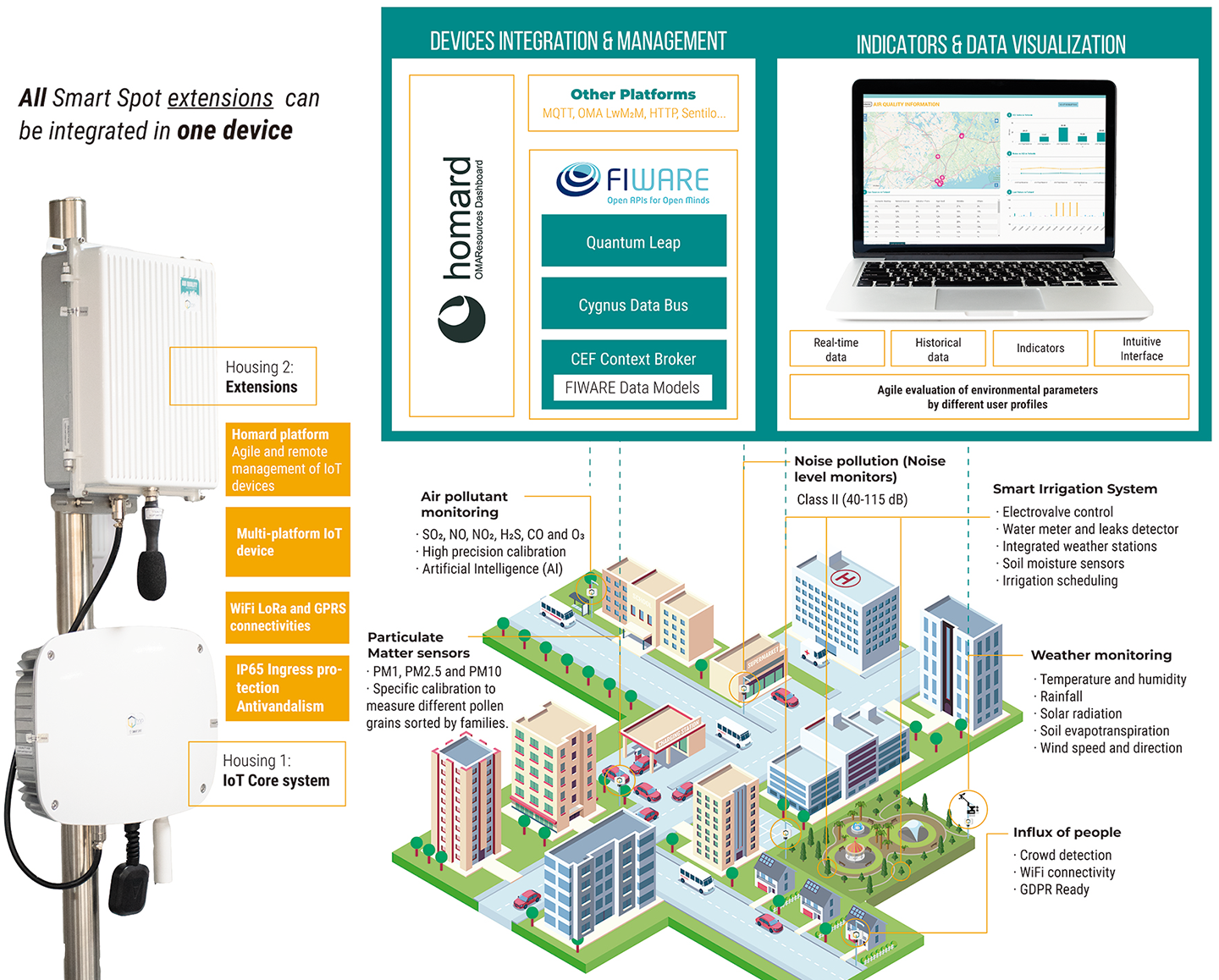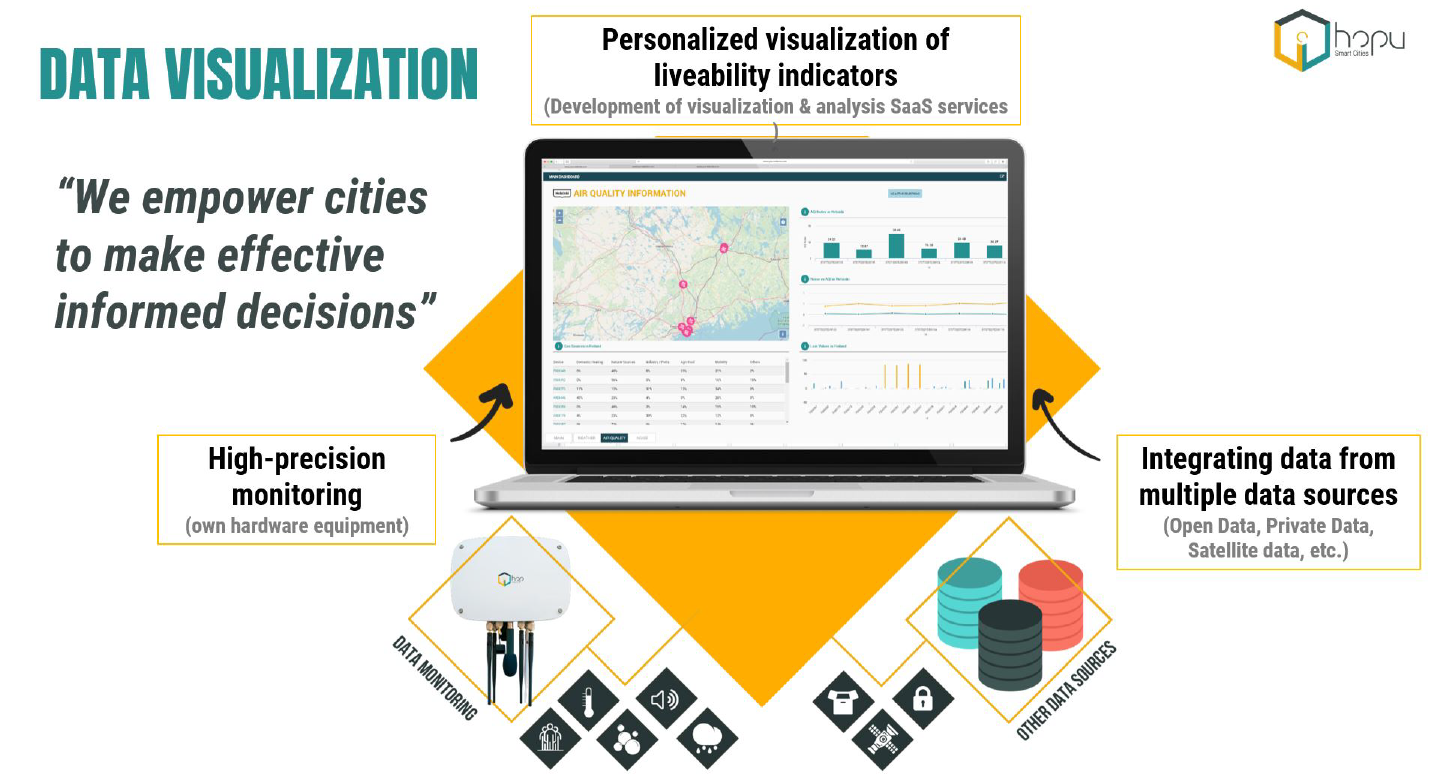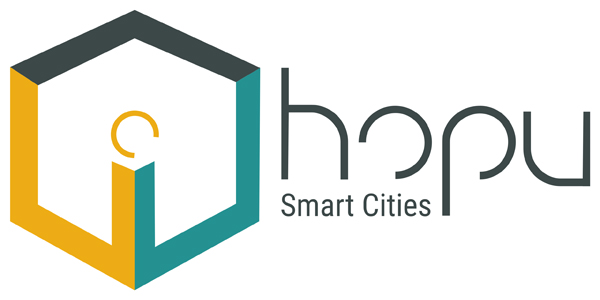Challenge & Context
Nowadays, being a smart and sustainable city is becoming more and more an objective of growing importance for public administrations. Lack of relevant and contextualized data is becoming a challenge for cities. Data contribute to the pollution reduction, to the creation of cutting-edge infrastructures and, to the increasing of innovative investments. In addition, financial and policy programs such as ERDF (Sustainable development funds), UIA (Urban Innovation Actions) and CEF (Connecting Europe Facilities) are requiring a deeper level of compromise and monitoring of Key Performance Indicators (KPIs) and sustainable development actions (i.e. reduction of emissions, enhancement of quality of life, and steps towards a green economy).
Many cities are facing challenges in the management of sustainable investments and access to grant opportunities which are based on three main issues to which urban planners are exposed:
- Difficulties to control the regulatory compliance levels, violation of laws and regulations;
- Lack of a global liveability index and social welfare, a comprehensive understanding of the global situation, the main needs and the best solution to address them;
- Lack of useful data, evidence-based indicators.
In this context, FIWARE together with the integration of advanced monitoring systems with highly guaranteed/certified data quality, AI-based modelling and forecasting algorithms, as well as the integration of contextual data over dashboards/DataViz are crucial for the support of sustainable investments and are hence expected to be included in the recently-signed EU Green Deal initiative. This initiative establishes a new model of financing and support for cities that are fighting climate change. Under the initiative, programmes such as the Innovation Fund (worth up to 10 billion euros) allocate 40% of the budget at the beginning of a given project, but ensure that 60% of the budget will be allocated later, depending on the results achieved/demonstrated by the projects. Therefore, there is a vital need to ensure evidence-based and data-driven actions. Most importantly, given the European commitment to become a sustainable continent by 2050, with a 55% reduction in CO2 emissions by 2030, it is time to look head-on at climate change and make a serious commitment.
Given such relevant challenges, the HOPU Ubiquitous company (Human-Oriented Products for Urban-environments) provides different services and products, based on the real needs and profiles of urban planners. By relying on the potential of data with technologies such as Artificial Intelligence, the Internet of Things (IoT), and the FIWARE ecosystem, HOPU contributes to sustainable urban design, helping cities to turn into even smarter environments. In addition, HOPU guarantees that the deployments are understandable, intuitive and usable, making the Smart and Sustainable Cities sector more accessible and agile for the city’s entire ecosystem.
Solution
HOPU’s solution allows cities to collect, analyse and visualize a large amount of data related to the environmental situation of cities in a simplified way. This includes sources of data on transport, utilities, social media data, open data and data coming from citizens’ own devices to offer an unique indicator that facilitates the understanding of the territory’s environmental state and main affected area.
HOPU’s services include air quality indicators to ensure that the United Nations’ Sustainable Development Goals can be achieved. In particular, HOPU focuses on helping sustainable cities and communities working on climate actions, here four (4) areas are mentioned:
- Air Quality index to know the state of air pollution in urban areas;
- Pollen service to control the particulate matter levels that may affect the population at risk, such as asthmatic, elderly or allergies;
- Sound level control to assess noise pollution in cities that affect inhabitants’ mental health;
- People flow measures to analyse crowd impact within the ecosystem.
To offer different high-quality indicator services, HOPU provides high-quality environmental monitoring devices to deploy smart infrastructures that enable the collection of environmental data from urban areas and create specific liveability indicators in order to support smart decision-making processes.
The range of IoT devices used enables the monitoring of air pollutants and greenhouse gases, particulate matter (including pollen, dust, VOCs), weather, noise pollution and people flow, providing relevant environmental data, which is then also cross-checked with external data sources such as private data, open data and satellite data.
These IoT devices designed by HOPU provide accurate data with more than 80% accuracy in environmental monitoring, 98% in sound level monitoring and 90% in people flow monitoring.
This solution uses the FIWARE Context Broker, which is currently part of the CEF Building Block Programme. Following the FIWARE Open Source approach and thanks to the Orion Context Broker, HOPU integrates datasets from different data sources such as energy consumption or water consumption, social media data, health aspects, among others, offering a solution that allows the analysis of all contextual data, and providing simplified indicators for decision-making.
Figure 1 . HOPU Ecosystem
How it works
Thanks to FIWARE Context Broker and the creation of easy indicators for visualization, the HOPU solution offers the monitoring of data through FIWARE-ready IoT devices, the combining of different datasets from satellite, open data, private data, census, social statistics and others. This is key to understand better the wide variety of data through a meaningful dashboard, based on Grafana.
Figure 2 . HOPU Indicators service
To offer different state-of-the-art indicator services, HOPU provides high-quality environmental monitoring devices to deploy smart infrastructures that enable the collection of environmental data from urban areas and create specific livability indicators in order to support smart decision-making processes.
Environmental monitoring IoT devices
Smart Spots are Internet of Things (IoT) devices that allow Hopu to monitor environmental factors such as harmful/greenhouse gases, particulate matter such as pollen, dust and VOC, temperature/humidity and noise. It has additional monitoring capabilities such as outdoor people flow, electricity consumption and can include weather stations to monitor rain, wind and solar radiation. The inclusion of all these sensors in a single device provides savings in installation, maintenance, management and communication. It is offered in multiple versions, including Wi-Fi, LoRa/SigFox or GSM/GPRS and protocols as the LwM2M and MQTT.
Smart Spot IoT devices offer a reliable and robust solution to assure compliance and supporting environmental emissions monitoring, and the preventive detection of anomalies.
Data quality/reliability is a critical differentiation aspect with regards to other solutions. Smart Spot offers certified data quality as IEEE P2510, validations by external institutions such as the Environmental Centre (CETENMA), demonstrating an excellent correlation with respect to reference data sources, and a guarantee and certification of calibration for every individually sold system by an accredited calibration laboratory (ISO 17025) by ENAC accreditation body.
Smart Spots are maintained with the (FIWARE-compatible) AI-empowered cloud platform called Homard for the preventive maintenance, fatigue compensation, and optimization of the data quality and calibration evolution.
These devices are a modular and cost-effective solution adaptable for specific needs, supporting reliable and high data quality for environmental monitoring, gases, and toxic substances identification. This is extensible with other contextual parameters such as noise, affluence of people and the relevant data sources for monitoring that support the understanding of the status to enable data-driven and evidence-based decision-making.
Data analysis/visualization
The software visualization data tool is based on FIWARE, and promotes the effective use of Open Source resources, which integrates datasets from utilities (energy/water), social (transport/affluence) and health (census/statistics) with the Smart Spot data to obtain indicators based on the needs of cities. It, thereby, enables a data-driven tool for systematic data collection, urban planning, and data analysis empowered by AI with the use of contextual information. This brings a higher capacity to understand needs considering cross-sectoral aspects (climate, sociology, urbanism), providing indicators, and correlations/analysis to identify the best potential solutions to bring better health, cleaner environment and climate action. This action is aligned with strong urban policies. Strategic urban planning is the key to creating supportive environments for health, making sure that health and equity considerations are integrated throughout the planning process, investments, and policy decisions.
The data visualization is FIWARE-based (https://opendata.hopu.eu/grafana/), enabling the configuration of alerts, data analysis, dashboards creation, multi-parameters monitoring/correlation, and integration/communication with other systems via MQTT, OPC-UA/Modbus, Open APIs and direct support of existing Smart Cities platforms, based on FIWARE.
Benefits & Impact
The main competitive advantage of the HOPU Smart City solution is that it unifies steps and systems from the data collection phase to the conclusion development for decision-making in a single and usable tool. Due to this global tool, cities can reduce the time dedicated to making informed decisions and automatically ensure that the decisions are more effective. In addition, the device’s configuration can benefit urban planners with regards to saving costs in management, the integration of different sensors, and installation
The HOPU Smart City solution for environmental monitoring includes the 4 main pillars that an informed decision-making solution must have unified into a single product. These four pillars are:
- A final solution adapted to each territory through interaction with the cities themselves. All the HOPU solutions are city-driven and they grow based on the city’s interaction;
- Use all available data sources in the territory as a global territory vision, including open data, private data, satellite data and social data from census and statistics;
- Simplification and abstraction to reach clear indicators, making the understanding of Big Data for the different urban planners’ profile easier;
- Adaptation of indicators to required regulations and parameters that cover the regulatory needs of territories, providing support in controlling and avoiding sanctions.
The Hopu’ solutions have been already successfully deployed in diverse cities, for example Madrid, Cartagena, Onda, Badajoz, Santander and La Palma. Moreover, it has also been deployed in Bruges and Mechelen (Belgium), composing a list of more than 25 cities throughout the world.
HOPU’s experience in the most diverse cities demonstrates the value of this service in the market and how it contributes to the knowledge revolution in the field of environmental health, following the principles of the World Health Organization by creating a system to exploit data for urban health.
Added value through FIWARE
The FIWARE Smart City platform components help in the software development of HOPU through enablers such as the Orion Context Broker and IoT agents. This technological structure — which follows a common European standard — has brought a very relevant angle for the public administration market towards being more integrable, open and standard.
According to Antonio Jara, CEO og HOPU:
“FIWARE is a great community where any SMEs can grow up thanks to the marketing opportunities and the chances of business that the foundation provides in the European market sector. HOPU has participated in more than 10 international events in the last years, collaborating with FIWARE. FIWARE has promoted HOPU as a FIWARE-ready Device in different networks of stakeholders and customers contributing actively to expanding our market”.
HOPU is furthermore an active and constant contributor of the FIWARE Foundation ecosystem supporting dissemination activities as FIWARE Evangelists, and working actively in the technological growth of the different enablers.
Hopu’s services and products have been supported by relevant networks in the area of sustainability such as CLIMATE KIC and through major European projects such as Synchronicity. Additionally, HOPU is Gold Member of FIWARE Foundation, part of OMA (real-time communication protocols OMA LwM2M, OMA NGSI) and Chair of IEEE in the IoT sector for Data Quality (IEEE P2510).
Next Steps
The HOPU company aims to grow in several areas between now and 2025:
- Create new indicators to detect pollution sources and low emission zones for urban security and urban health;
- Include new monitoring parameters in Smart Spot to cover the needs of the market;
- Define local partners in countries such as Belgium, Germany, France, Italy as well as Latin America;
- Rolled-out in more than 200 cities.
References
- Open Data Portal
- Smart Spot datasheet
- Cartagena experience
- Synchronicity EU Project



